Are we ready to have parties again yet? Because we’re yearning for a chance to make another giant grazing table. A giant grazing table is basically a charcuterie board… but it takes up an entire table. It’s a spread that’s practically overflowing with easily accessible, bite-sized morsels. Your guests can walk around the table and graze to their hearts’ content. So let’s take a look:
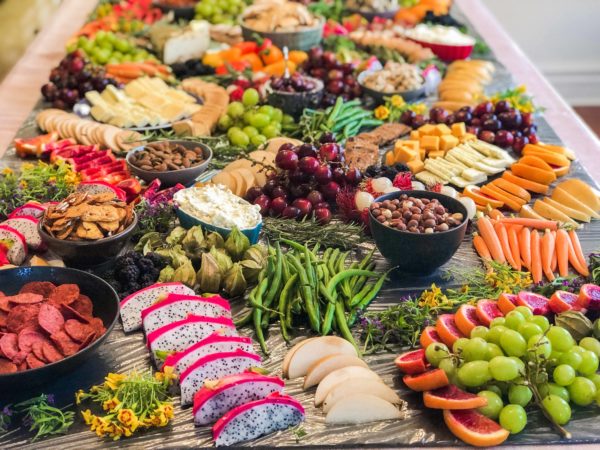
How Do You Prepare A Giant Grazing Table?
To protect your table, there are a few things you can do. Lots of people suggest butcher paper. However, we’ve found that paper can get soggy and start to look tired after a few hours of a party. We prefer having some kind of plastic to line and protect the table.
Your first go-to choice might be a vinyl or disposable plastic tablecloth, either of which you can wipe clean. For one Superbowl party, we used a plastic tablecloth with a green “grass” design so it looked like a giant field.
To create the table pictured here, we covered it in black posterboard. Then we took long strips of plastic wrap and covered the posterboard (and taped it all down underneath).
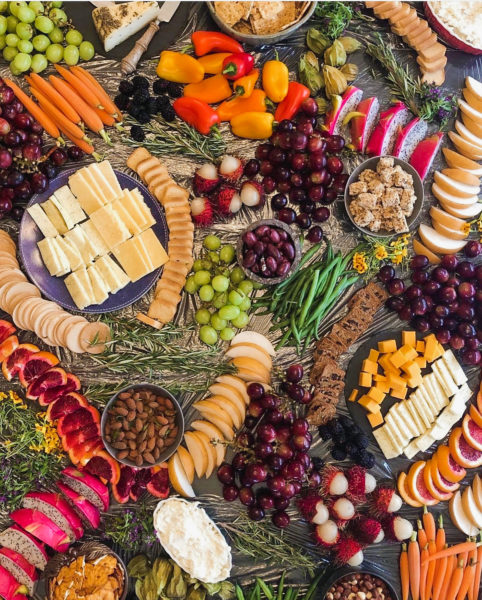
You may also cut black trash bags and tape them down on the table. (However, for some folks, that’s the least aesthetically pleasing option).
What Supplies Do You Need For A Giant Grazing Table?
Once you have your surface laid down, you need to get some supplies. Let’s go piece by piece:
Bowls: You will need a few small- to medium-sized bowls in a variety of interesting shapes, sizes, or colors. (Or keep them all one color if you want a unified “look.”)

Boards: You should gather a few small boards that you can use for slicing cheeses or for visually separating out different kinds of foods.
Serving Utensils: You will need a variety of cheese knives, butter knives, small forks, and spoons.
Eating Utensils: Not everything on your table may work as finger food (or your guests might not want to eat them as finger food). You will need to offer forks or spoons so guests can eat their selections delicately as they mingle and chat. We’ve found a fun variety of tiny forks and spoons at the dollar store. The ones pictured below are about 4 inches tall.
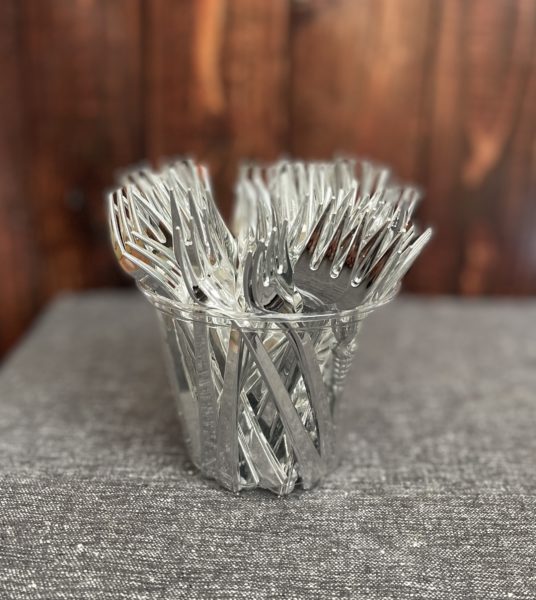
Plates and Napkins: You don’t need full-sized plates or napkins; dessert or cocktail sizes will work just fine for a grazing table. Plan to offer them at several points around the table so a guest could walk up at any point and grab something.
What Food Should You Put On A Giant Grazing Table?
Here comes the fun part: Picking out the food for your giant grazing table.
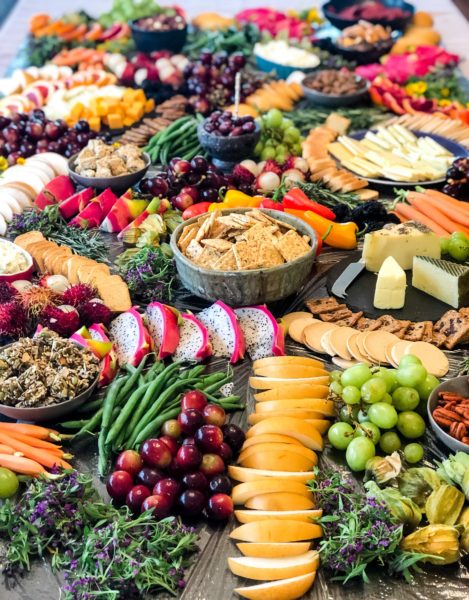
Fruits And Veggies
We always find it easiest to start with fruits and veggies. Look for fruits and veggies that are colorful and will hold up over the length of the party. For example, grapes in a variety of colors will always fit the bill. Apples are good and sturdy, but they tend to turn brown. If you’re going to use apples, give them a spritz of lemon juice.
Some choices include:
Fresh fruits: Grapes (red, green, black); Strawberries (thinly slice them and fan them out for maximum visual appeal); Apples (see above, spritzed with lemon and then sliced); mango cubes or slices; melon cubes or slices; raspberries, blueberries, or blackberries; exotic fruits such as dragonfruit (the pink variety packs a punch when it comes to visual appeal); papaya; or rambutan.
Dried Fruits: Figs, dates, dried apricots, dried cranberries. If you can find some tasty dried apples, peaches, or strawberries those are also fun.
Veggies: Carrot sticks, celery sticks, jicama sticks, green beans, broccoli spears, cauliflower spears (purple or gold cauliflower is always fun), bell peppers, cherry tomatoes.

Purple cauliflower is a colorful addition to the mix. Here’s it’s pictured next to our butternut squash ‘hummus.’
Cheeses and Meats
Look for cheeses in a variety of shapes, colors, textures, and flavors.
Some choices include:
Hard or semi-hard cheeses: Parmigiano-Reggiano, manchego, asiago, aged gouda.
Soft or semi-soft cheeses: Havarti, brie, burrata, goat cheese.
Cheese spreads: Boursin, pub cheese, cream cheese.
Make sure you have plenty of knives and/or spreaders available for serving.
For your meats, dried or cured meats are the best and least messy options. Pick a variety of salamis, hams, prosciutto, or dried sausages.
Crackers or Breads
When there’s cheese, there should be crackers. Offer up a variety of crackers, as well as baguette slices or pita triangles for easy bite-sized mouthfuls.
Condiments and Other Add-Ons
For the final touches to your giant grazing table, here’s a chance to add a variety of flavors (and fill any remaining spaces).
Savory items: Hummus, nuts, flavored mustards, dips, pickles, or olives. If you have a really exquisite olive oil, such as Olio Piro, set some out in a special bowl with a tiny spoon.
Sweet items: Honey, jam, or even chocolates. Our favorite chocolate, Vine to Bar chocolate, is sustainable and a great conversation starter.
Decorative items: Herbs, small edible flowers, or larger (non-edible flowers) as long as they’re presented in a way such that people know they are not to be eaten, and/or wrapped candies.
How Do I Assemble a Giant Grazing Table?
Here’s where the artistry comes in. To lay out the items, start with the largest items first. If you have a few small cheese boards featuring cheeses and meats, put those out first, at different points around the table.
After that, plan out a few “entry stations” around the table where you will offer plates, napkins, and utensils.
Next fill in spaces with bowls and/or baskets of crackers and breads.
Then line up the fruits and veggies in patterns around the boards and bowls. If you’ve sliced the fruits or veggies, neatly fan out the slices.
Next fill in any other empty spaces with tiny condiment bowls.
And finally, add your decorative touches such as herbs, flowers, or candies.
And don’t forget to take a picture (or get someone else to take a picture) of you with your handiwork!
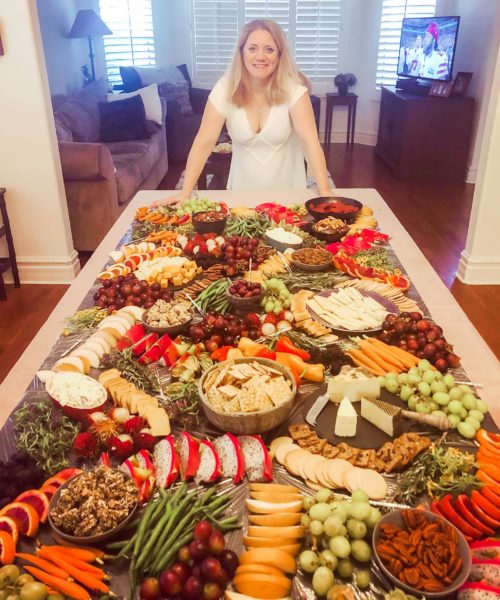
What Else Should I Know About Serving A Grazing Table?
Here are a few other tips as you manage your gathering:
- Consider using small signs or placards to identify each food, especially if you’re serving unique or unfamiliar items.
- Help guests with special diet needs by making sure they know which items are safe or which to avoid.
- Keep an eye on the table so you know if something needs a refill (or a cleanup).
- Remember that fruits, veggies, most condiments, and most cheese should all be fine at room temperature for about four hours. For meats that need to be refrigerated, consider swapping them out every two hours or bring them out in shifts.
- Offer a variety of wines and sparkling beverages.
At the end of the day, what’s the best part of having a giant grazing board? It’s a built-in conversation piece! Let your guests mingle as they graze, and you can sit back and enjoy yourself.
P.S. Do you want hummus for your grazing table? Of course you do – and we have recipes. We mentioned the butternut squash ‘hummus’ above. There’s also chestnut hummus, turmeric hummus, jackfruit seed hummus, and black garlic pumpkin hummus. Take your pick!
Blogger disclosure: This post contains affiliate links.


 Hi! I'm Jeanne Fratello - a writer, reporter, and food enthusiast who is on a mission to write great stories about food and where your food comes from.
Hi! I'm Jeanne Fratello - a writer, reporter, and food enthusiast who is on a mission to write great stories about food and where your food comes from.
No comments yet.